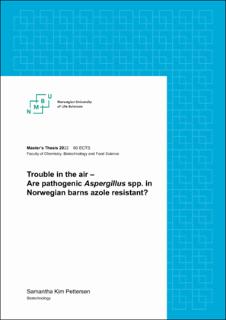| dc.contributor.advisor | Skaar, Hanne Ida | |
| dc.contributor.advisor | Divon, Hege Hvattum | |
| dc.contributor.author | Pettersen, Samantha Kim | |
| dc.coverage.spatial | Norway | en_US |
| dc.date.accessioned | 2022-12-07T09:43:04Z | |
| dc.date.available | 2022-12-07T09:43:04Z | |
| dc.date.issued | 2022 | |
| dc.identifier.uri | https://hdl.handle.net/11250/3036290 | |
| dc.description.abstract | Aspergillus fumigatus and Aspergillus niger are saprotrophic, ubiquitous fungi and some of the lead causes of aspergillosis; a human and animal fungal infection with high mortality rate. Azoles are one of the few efficient antifungal agents used to treat aspergillosis, however, a rise in azole resistant fungi have become increasingly widespread. It is thought that use of azoles in the environment, such as in agriculture, is the main driving force of this development. Little is known about the prevalence of azole resistant fungi in Norway. The current study is part of the research project “BARNS” where the aim is to map out the prevalence of azole resistant A. fumigatus and A. niger in Norwegian farm buildings.
Air samples from farms were gathered through a citizen science approach and cultivated on DG18 agar. Environmental isolates of A. fumigatus and A. niger were isolated and identified by morphology and caM and bT2 sequencing. This resulted in 58 A. fumigatus isolates, whereas 37 A. niger isolates were molecularly corrected to Aspergillus tubingensis and Aspergillus welwitschiae. All fungal isolates were screened for resistance against three medical azoles; itraconazole, voriconazole and posaconazole, using VIPcheckTM. Together with three clinical isolates from the Norwegian Veterinary Institute’s strain collection, the environmental isolates with indications of resistance were further tested against the same azoles using E-test. Isolates that showed phenotypical azole resistance were screened for known environmental mutations in the cyp51A gene and promoter region (i.e. TR34/L98H and TR46/Y121F/T289A). The results were compared to a previously conducted sampling round within the same project.
None of the environmental isolates in this study showed phenotypic resistance on E-test to any of the azoles tested, and were therefore not sequenced. In comparison to the previous sampling, both the number of isolates and detection of resistance were much lower in this study. This was unexpected as seasonal temperature differences were believed to be a major factor in proliferation of the fungi. Other external determining factors for fungal proliferation may be the presence and activity around animals on the farms. The three clinical isolates all showed phenotypic resistance to all three azoles on E-test, and they all harboured the TR34/L98H mutation in cyp51A. This is consistent with the hypothesis that environmental driving forces affect the development of resistance.
The low sampling number and the one-sided focus on Norwegian farms is not sufficient to draw any clear conclusions on how prevalent azole resistant A. fumigatus and A. niger are in Norway. However, the lack of findings might indicate that the prevalence is fairly low compared to other countries. | en_US |
| dc.description.abstract | Aspergillus fumigatus og Aspergillus niger er saprotrofiske sopp som finnes overalt og er blant de ledende årsakene til aspergillose; en soppinfeksjon med høy dødelighet hos dyr og mennesker. Azoler er et av de få effektive antimykotiske midlene som brukes til å behandle aspergillose, men azolresistente sopp har begynt å bli mer utbredt. Bruk av azoler i miljøet, som for eksempel i landbruk, er antatt å være den største drivkraften til denne utviklingen. Utbredelsen av azolresistens i Norge er ukjent. Denne studien er en del av “BARNS”-prosjektet, hvor målet er å kartlegge utbredelsen av azolresistente A. fumigatus og A. niger i norske gårdsbygninger. | en_US |
| dc.language.iso | eng | en_US |
| dc.publisher | Norwegian University of Life Sciences, Ås | en_US |
| dc.rights | Attribution-NonCommercial-NoDerivatives 4.0 Internasjonal | * |
| dc.rights.uri | http://creativecommons.org/licenses/by-nc-nd/4.0/deed.no | * |
| dc.title | Trouble in the air : are pathogenic Aspergillus spp. in Norwegian barns azole resistant? | en_US |
| dc.title.alternative | Trøbbel i luften : er patogene Aspergillus spp. i norske låver azolresistente? | en_US |
| dc.type | Master thesis | en_US |
| dc.description.localcode | M-BIOTEK | en_US |

